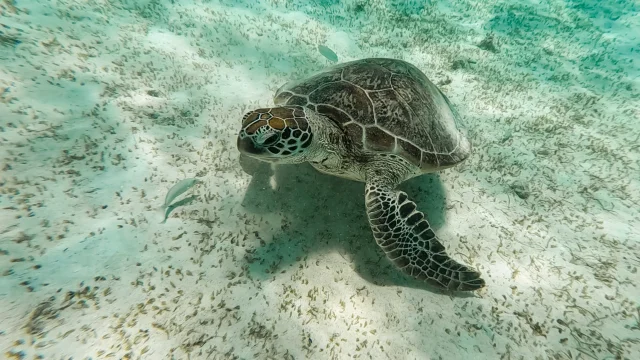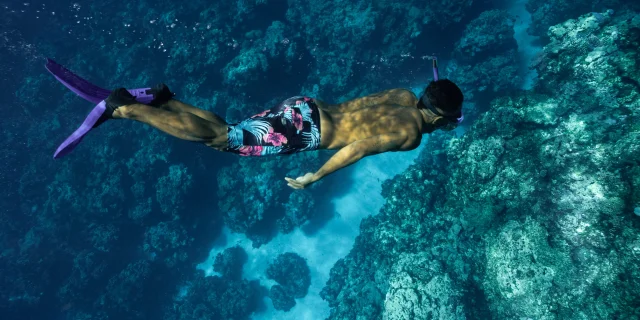 Blue Caledonia Diving Charlotte Bertonneau 202
Blue Caledonia Diving Charlotte Bertonneau 202 Blue Caledonia Diving Charlotte Bertonneau 202
Blue Caledonia Diving Charlotte Bertonneau 202 Ilot Brosse Charlotte Bertonneau Patrice Hauser 07595
Ilot Brosse Charlotte Bertonneau Patrice Hauser 07595 Blue Caledonia Diving Charlotte Bertonneau 202
Blue Caledonia Diving Charlotte Bertonneau 202Diving doesn’t always mean full gear and formal training. All you need is a mask, snorkel, and a pair of fins to admire the many fish right off the coast of South Province. Snorkelling, or as they call it here, “PMT” (Palmes, Masque, Tuba), is popular all around the lagoon. They’ve even set up underwater trails to increase your odds of spotting parrotfish, surgeonfish, clownfish, and other colourful species. For top picks, we recommend checking out the underwater trails at Ilot Canards underwater trail, the Poé underwater trail, as well as the seabed around the Signal Island and the Amédée lighthouse. For a unique experience, head over to the Pontoon in Sainte-Marie Bay: it’s got an underwater tunnel, a restaurant, and sun loungers for a day of complete relaxation!
New Caledonia’s mild, sunny climate means you can enjoy snorkelling all year round! But watch out for that sunburn! Before diving, don’t forget to put on a rash guard – you’d be surprised how red you can get in the water. Corals are fragile, so opt for a coral-friendly sunscreen.
 Piscine Naturelle Doro Charlotte Bertonneau Patrice Hauser 265
Piscine Naturelle Doro Charlotte Bertonneau Patrice Hauser 265 Manager
Manager Ilot Brosse Charlotte Bertonneau Patrice Hauser 07204
Ilot Brosse Charlotte Bertonneau Patrice Hauser 07204The clear waters of the Caledonian lagoon and the passes near the coral reef promise top-notch diving. In most of the passes outside the lagoon, you can spot numerous pelagic species: sharks, manta rays, dolphins and dugongs. And of course, you can see turtles without even needing to suit up. Coral reefs are home to many species of fish. You’re in one of the world’s most beautiful marine reserves, in an area listed as a UNESCO World Heritage Site. It’s no surprise that the biodiversity here is extraordinary, both in and out of the lagoon. Apart from the passes around Nouméa, most diving centres offer explorations of Grande Terre sites, such as the famous Prony needle, the canyons of La Foa or the wonderful drop-offs of the Great South.
During the cool season (April – November), you’ll enjoy better visibility (30 to 40 meters). You’re also likely to spot whales along the way. The water remains quite pleasant during this period (around 22°C).
New Caledonia’s South Province is home to a large number of high-quality dive sites, both inside and outside the lagoon. Among the most beautiful must-visit spots during your explorations are:
 Blue Caledonia Diving Charlotte Bertonneau 115
Blue Caledonia Diving Charlotte Bertonneau 115The shipwrecks in the lagoon are a delight for seasoned divers. They’re home to a wealth of marine life. Among the most remarkable shipwrecks, don’t miss out on:
There are many excellent diving centres in South Province. Qualified instructors offer a range of services for all levels, so it’s easy to take your first dive in Nouméa, Bourail, La Foa or Île des Pins. You can dive all year round, and introductory dives can be booked in advance. Typically, a baptism consists of an introductory dive, preceded by a safety briefing and supervised at all times by your instructor-guide. Lasting from 30 minutes to 1 hour, this first experience will give you the chance to see a host of aquatic creatures, and promises some great thrills.
Most dive centres are affiliated to a certification body or an international federation, which means that you can easily pass your diving levels in South Province: ANMP / CEDIP training (Levels 1, 2, 3, 4), PADI training. Dives typically take place in the morning. During an expedition, you’ll do two dives on the same trip after a boat ride of 15 to 45 minutes. Diving visibility generally ranges from 15 to 40 meters. You can rent diving gear directly at the club for an extra fee
 Ouest Corail Charlotte Bertonneau 137
Ouest Corail Charlotte Bertonneau 137Diving into the mysterious nighttime atmosphere can be a weird mix of chills and wonder. Once you get past those initial (slight) jitters, you’ll be fascinated by the fluorescent corals and the abundant aquatic species that you can see during these hours. Night dives generally take place in the early evening, between 6pm and 8pm depending on the time of year. Most of them take place not far from the Nouméan coast, like Seiche-Croissant.
New Caledonia’s ecosystem is incredibly rich but also quite fragile. Protecting the underwater environment ensures that you can enjoy exceptional dives for a long time to come. So, here are a few tips to keep in mind during your explorations:
 Nautica Charlotte Bertonneau 12
Nautica Charlotte Bertonneau 12